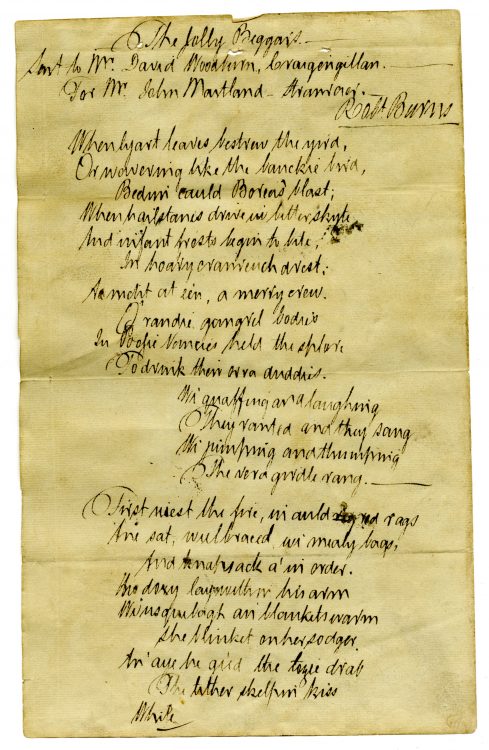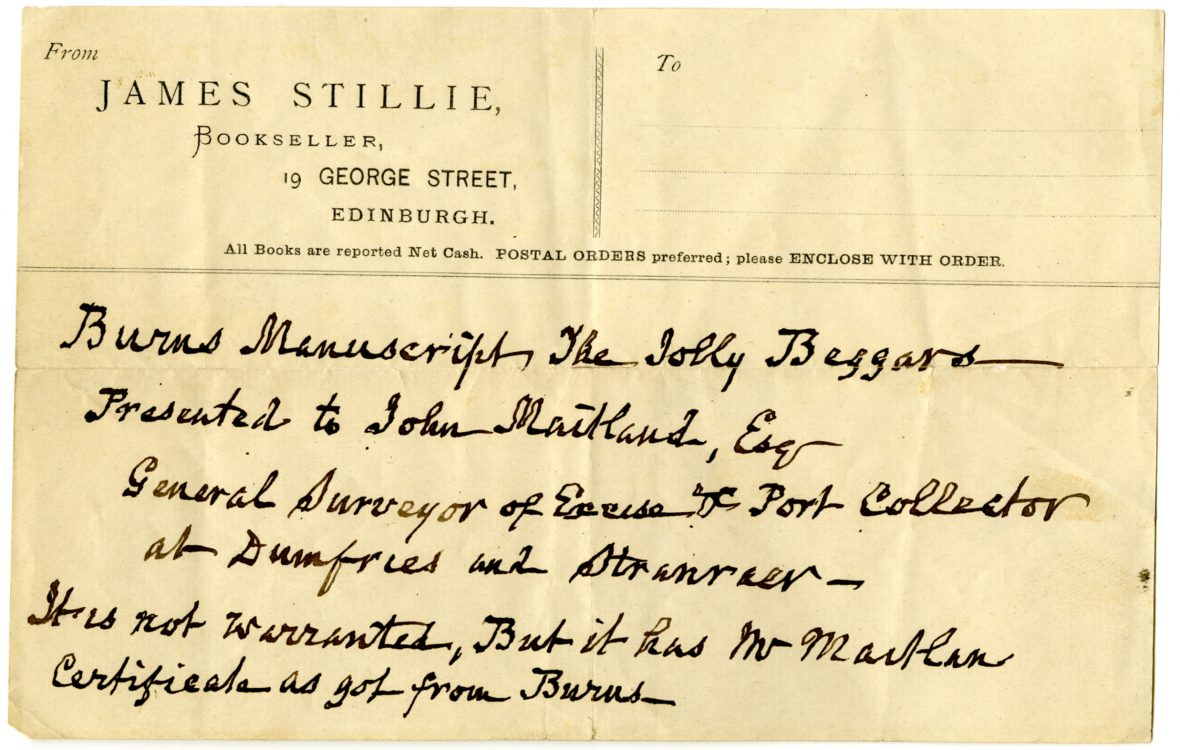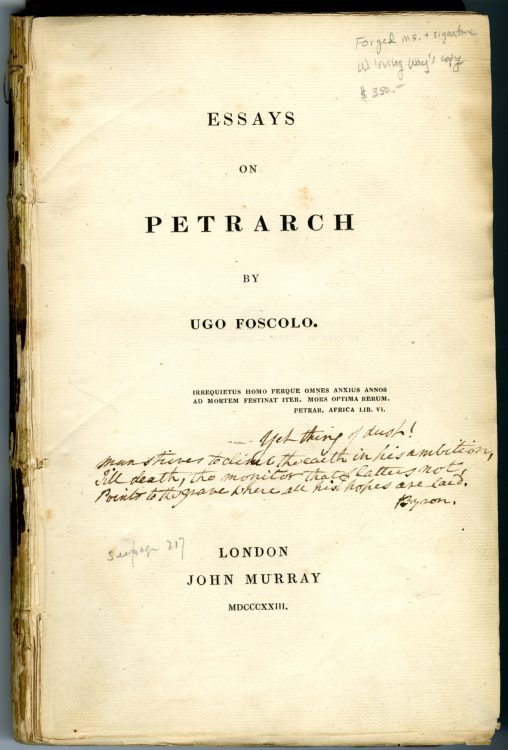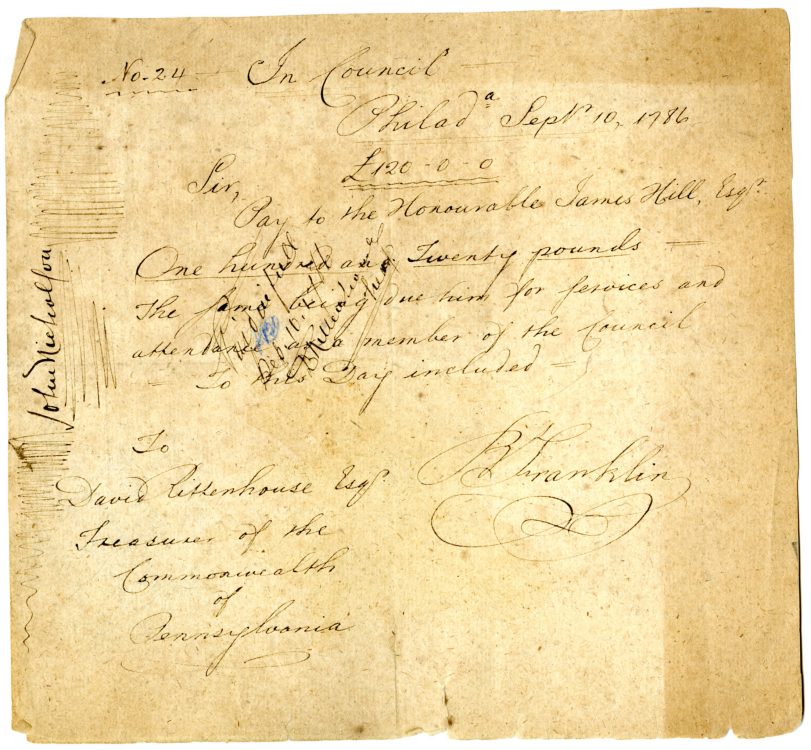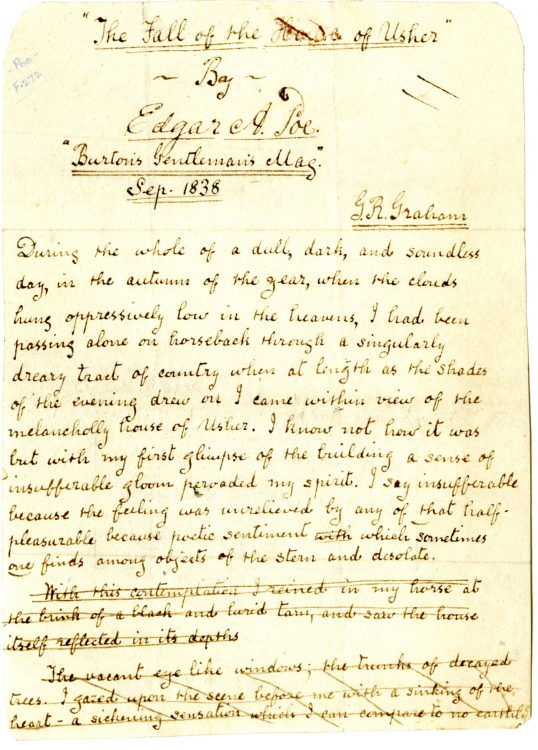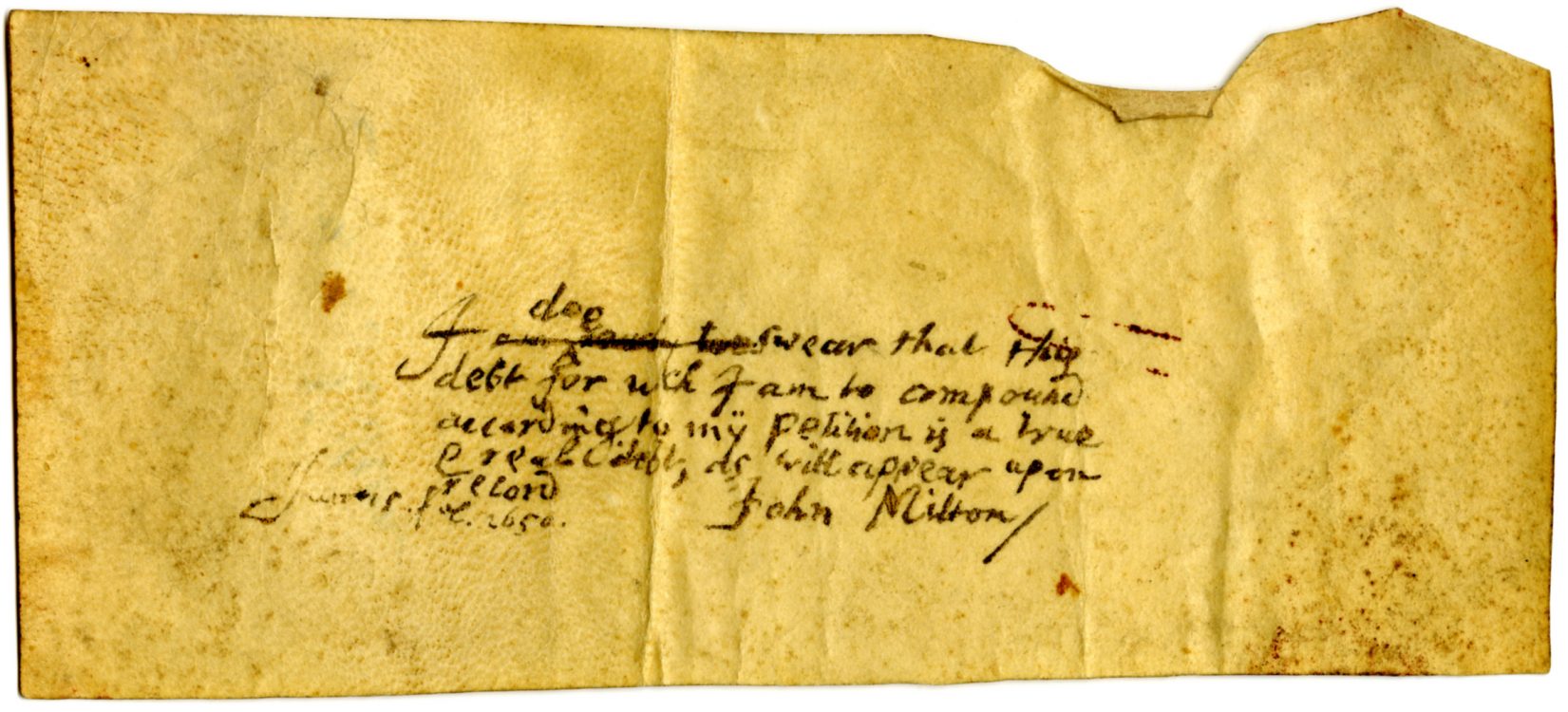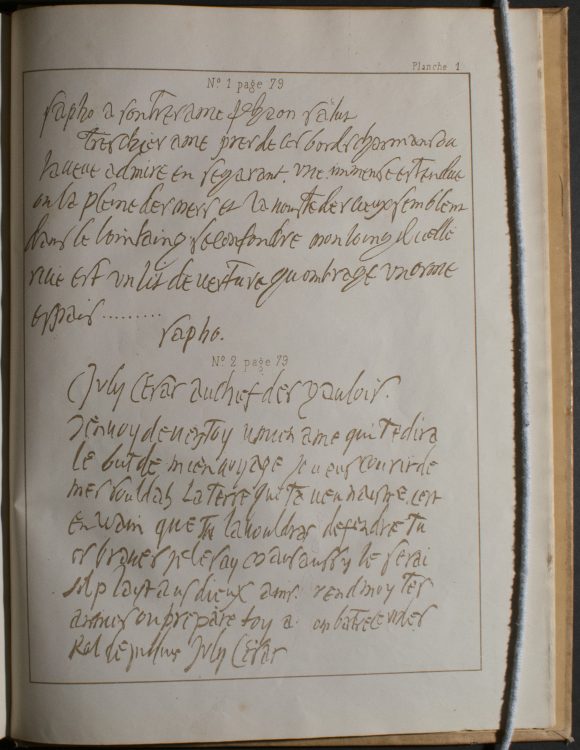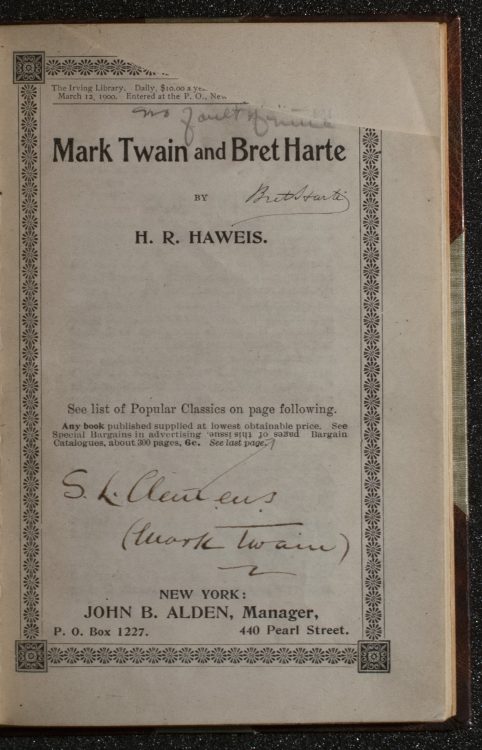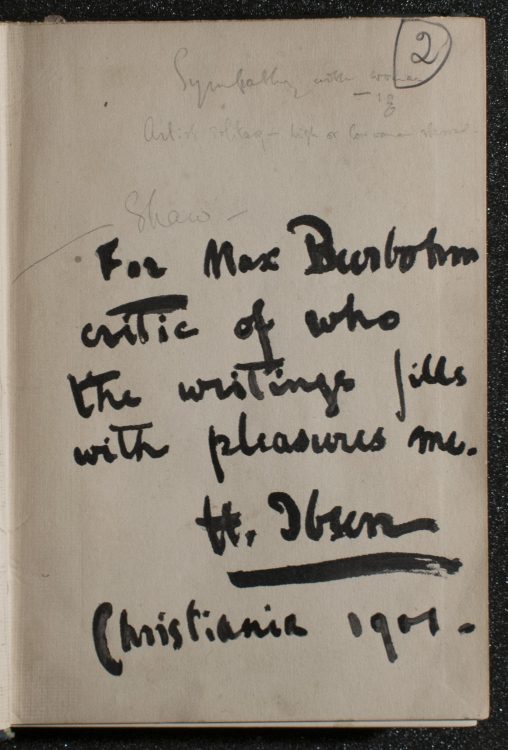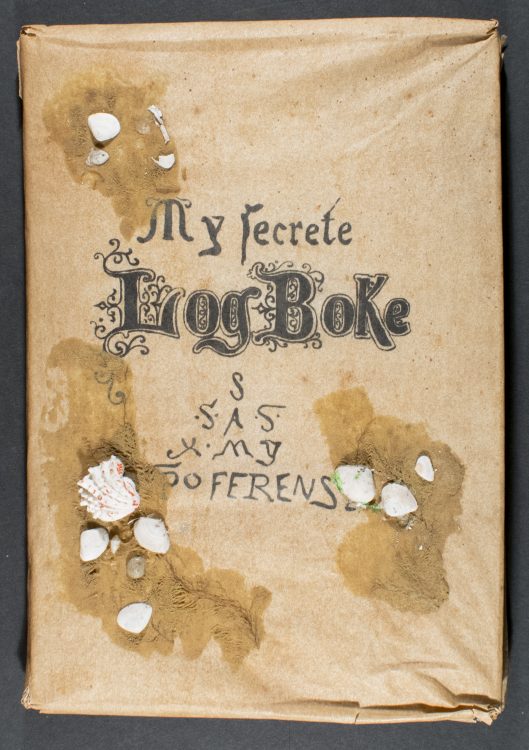[Spanish Forger]
Pawnbroker, with a young couple buying or selling a gold cup, illuminated manuscript leaf on vellum, [circa 1910, in imitation of a medieval manuscript]
Frank W. Tober Collection on Literary Forgery
In the late nineteenth and early twentieth centuries, the so-called Spanish Forger was responsible for a great number of fraudulent medieval manuscripts. He was known as the Spanish Forger because one of his first-known forgeries was mistaken for a genuine piece by the fifteenth century Spanish artist, Jorge Inglés. In reality, the Spanish Forger was probably not Spanish: most of his fakes first appeared in France. Stylistic similarities suggest that the forgeries were made by one person, but there is also speculation that the Spanish Forger was actually a group of collaborators. To this day, nothing is known about his identity.
In order to give his work an appearance of authenticity, the Spanish Forger used genuine medieval vellum and parchment for his work. Sometimes he would complete unfinished illustrations or add new ones to real manuscripts. Many of his fakes were based on medieval illustrations that were reproduced in books by Paul Lacroix between 1869 and 1882, which indicates when he could have begun his forgeries. His forgeries were first debunked in 1930 by Bella da Costa Greene (1879-1950), curator at the Morgan Library.
Stylistically, the Spanish Forger’s creations are unlike real medieval artwork. He produced figures with facial expressions that were unlike those found in medieval illustrations. Quite noticeably (and as can be seen here), his female figures are drawn with exposed cleavage, which is not found in medieval art. When reusing medieval leafs, he often selected religious texts and supplied them with unrelated scenes of secular life. Finally, chemical analysis has shown that he was using pigments that did not exist in the Middle Ages, including ultramarine blue, Scheele’s green, and copper arsenite, which were not available until 1828, 1775, and 1814, respectively.
[Alexander Howland Smith (1859 - ?]; Forgery of Robert Burns (1759-1796). Forged autograph manuscript, The Jolly Beggars, “circa 1786” [actually circa 1880-1890]
Alexander Howland Smith Papers
[Alexander Howland Smith (1859 - ?]; Forgery of Robert Burns (1759-1796). Forged autograph letter, Robert Burns to John Maitland, [circa 1880-1890]
Alexander Howland Smith Papers
James Stillie (circa 1803-1893). Manuscript note, [circa 1880-1890]
Alexander Howland Smith Papers
Alexander Smith (also known as “Antique” Smith) was a forger from Edinburgh. He created hundreds of forged documents, and he specialized in Robert Burns and Sir Walter Scott. A law clerk, he used his forgeries to supplement his income, beginning sometime in the late 1880s. (He started by selling genuine manuscripts that were given to him by his employer; he moved on to fakes after running out of real ones). Allegedly, the bulk of Smith’s profits funded his drinking habit. In making and selling fakes, Smith benefited both from his technical skills as well as from customers who, having spent a great deal of money on fakes, did not want to see them exposed as frauds, and thus became complicit parties. Smith flooded the market, often selling at bargain rates. In 1892, the Edinburgh Evening Dispatch published a series of articles on the fakes and included facsimiles of some. Here, Smith’s day job undid him: a reader saw that the handwriting in the forgeries was similar to Smith’s. Arrested, Smith was charged and convicted of selling forgeries under false pretenses. He served twelve months in prison and vanished from the historic record.
In this example, Smith had fabricated a sixteen page manuscript of a genuine Burns poem, “The Jolly Beggars,” along with a letter by Burns, also forged, purporting to present this manuscript to John Maitland, circa 1786. Beside them is a note advertising the items for sale by James Stillie, a dealer who often worked as a co-conspirator with Smith.
[Major Byron (1810-1882)]; Forgery of Lord Byron (1788-1824)
Forged Byron manuscript, undated, in a copy of Essays on Petrarch (London: J. Murray, 1823)
The title page of this book has four lines of verse and Byron’s signature, as forged by the so-called Major Byron. Major Byron claimed to be Lord Byron’s illegitimate son, born of an affair with a Spanish countess. (Byron never spoke of this affair, and his family and friends had never heard of it.) He tried, unsuccessfully, to use his alleged lineage to borrow money from Byron’s surviving family and friends. Around 1844, he obtained a set of Byron letters, which supplied a model for a series of Byron forgeries. He spent several years selling his forgeries to collectors, mostly in London, before retreating to America in 1852, after his fakes had been conclusively exposed. He never suffered any legal consequences.
The lines inscribed on this copy are from a translation, ascribed to Byron, of “The Death of Mago,” from Petrarch’s Africa. The translation was printed in this volume and, in this copy, Major Byron has crossed out the attribution to Byron and written in “Medwin.” In the 1820s, Ugo Foscolo asked Lord Byron to supply a short translation of Petrarch’s Africa, for an appendix to the book. Byron disliked Africa and wanted nothing to do with it, so he passed the project to his friend Thomas Medwin (1788-1869). Medwin, who also disliked Africa, wrote a translation in Byron’s name and, with Byron’s blessing, sent it to the publisher. The main point of this was to prank Foscolo and see how he would react. Byron found it hilarious when Foscolo responded with a grateful letter of acknowledgment. Byron thought there were only “three good lines” in the entire poem: the same lines inscribed on this copy. Thus, with his forgery, Major Byron created the illusion that Lord Byron had corrected this copy to identify Medwin’s authorship.
Joseph Cosey (1887 – circa 1950s)
Joseph Cosey (an alias used by Martin Coneely) was one of the most prolific American manuscript forgers. A petty thief as well, Cosey spent most of the 1920s in and out of prison. In 1929 he visited the Library of Congress to view a collection of Benjamin Franklin manuscripts and stole one as a souvenir. Sometime in the 1930s, Cosey tried to sell the manuscript to a rare books and manuscripts dealer, but the dealer dismissed it as a fake. This inspired Cosey to create his own fakes and see if he could sell them as genuine. He specialized in producing forgeries of eighteenth and nineteenth century political and literary figures. Cosey sold his forgeries for much less than they would have been worth if genuine, which probably helped him avoid closer scrutiny. He also tended to stick to the letter of the law by making no claims as to the documents’ authenticity. Once, though, he was arrested for selling fraudulent goods and spent a year in prison.
To make his forgeries, Cosey studied facsimiles to imitate the person’s handwriting. Sometimes he used paper that dated from the period in question. Other times he dyed his paper to make it look like the appropriate paper stock. He also imitated the iron gall ink used during the time of the American Revolution by mixing rusted iron filings with Waterman’s brown ink. Although his forgeries displayed a great deal of sophistication, they showed some imperfections. He ignored the fact that a person’s handwriting may change by degrees as a person ages. For example, when forging Benjamin Franklin, he always imitated Franklin’s handwriting as he produced it in his youth. Another challenge of forging handwriting is that the forger has to carefully and painstakingly imitate script that the original person would have produced naturally and with ease. Thus, forged handwriting will often look over-precise and over-pronounced, especially when compared to an authentic manuscript.
[Joseph Cosey (1887 – circa 1950s)]. Forgery of Aaron Burr (1756-1836).
Forgery of a payment authorization signed by Aaron Burr, September 10, 1783 [actually circa 1930s]
Frank W. Tober Collection on Literary Forgery
Aaron Burr’s signature evolved, stylistically, over the course of his life. In this case, Cosey’s imitation of Burr’s signature is closer to how Burr wrote it in the early nineteenth century.
[Joseph Cosey (1887 – circa 1950s)]. Forgery of Benjamin Franklin (1706-1790).
Forgery of a payment authorization signed by Benjamin Franklin, September 10, 1786 [actually circa 1930s]
Frank W. Tober Collection on Literary Forgery
Cosey’s imitation of Benjamin Franklin’s signature comes very close to imitating the original. However, the handwriting and content of the payment is almost identical to that found in other confirmed Cosey forgeries. Most telling of all, though, is that Cosey made no effort to imitate the signatures of John Nicholson (1756-1844) and David Rittenhouse (1732-1796), both of whom were important figures in the American Revolution.
[Joseph Cosey (1887 – circa 1950s)]. Forgery of Edgar Allan Poe (1809-1849).
Forged manuscript, “The Fall of the House of Usher,” August 7, 1837 [actually circa 1930s].
Frank W. Tober Collection on Literary Forgery
[Joseph Cosey (1887 – circa 1950s)]. Forgery of Edgar Allan Poe (1809-1849).
Forged manuscript, “Shadow”, undated [actually circa 1930s].
Frank W. Tober Collection on Literary Forgery
In 1939, William H. Koester (1887-1965) compared these manuscripts to authentic Poe manuscripts and concluded that they were suspicious. He did not feel qualified to say that they were definite forgeries, but subsequent research shows that the handwriting on them is identical to that used in Cosey’s other Poe forgeries. Cosey imitated Poe’s handwriting as it appeared near the end of Poe’s life, regardless of the date assigned to the fake. Additionally, because Cosey was taking great care to write each letter as Poe would have written them, the resulting handwriting is much more precise than Poe’s actual handwriting.
Forgery of John Milton (1608-1674).
Forged manuscript document on vellum, June 25, 1650 [actually, probably no earlier than 1861; no later than 1941].
Frank W. Tober Collection on Literary Forgery
This forgery was produced by making a tracing of a genuine Milton document. The original was printed in facsimile in 1861, which is probably how the forger was able to access a working template. Even the shapes of individual letters and the spacing between words in this document are identical to that of the facsimile. This forgery was debunked in 1941.
Henri Léonard Bordier (1817-1888)
Une Fabrique De Faux Autographes Ou Récit De L'affaire Vrain Lucas. Paris: Léon Techener, 1870.
Vrain Lucas (1818-1882) forged over 27,000 manuscripts over a period of at least eight years. In 1852 he left his hometown of Châteaudun for Paris, where he hoped to work in either a library or a bookstore, only to be denied both due to his limited education. Instead, he found employment at the genealogical collection of Letellier. Letellier’s firm was known for providing spurious ancestries, often based on forged documents, so that their clients could claim to be descended from illustrious lineages. Lucas’ first known forgeries were performed for this firm, and this may be where he found the inspiration to create historical documents. He began forging letters by significant historic figures – such as Galileo, Newton, and Pascal – which he sold for a profit. He artificially aged the documents by water-damaging them, holding them over a lamp, or burning the edges. (Often, the documents clearly had watermarks that post-dated their alleged date of creation.) By about 1866, his forgeries had become more and more brazen, with Lucas producing handwritten documents by ancient and Biblical figures, such as Judas Iscariot, Mary Magdalene, and Lazarus. He even forged a letter that was supposed to have been written by a French physician, Castor, to Jesus Christ. All of these letters were written in modern French. Amazingly enough, collectors purchased Lucas’ fakes, apparently believing them to be genuine. One of his main clients, Michel Chasles, seems to have thought that they were sixteenth century transcripts, but that they were still based upon genuine texts from antiquity. From
Chasles alone, Lucas received somewhere between 140,000 and 150,000 francs.
In 1867, Chasles presented his Pascal manuscripts to the French Academy of Science. This proved to be Lucas’ undoing, as the members of the Academy quickly noticed the handwriting in Chasles’ documents was markedly different from the handwriting found in other, genuine Pascal documents. Additionally, the documents were riddled with anachronisms. Chasles identified Lucas as the source of the documents, which prompted the Academy to question Lucas about their authenticity. For a while, Lucas produced additional forgeries, in an attempt to verify his earlier forgeries. In 1869 Lucas was arrested for forgery, and in 1870 he was sentenced to two years in prison. He served out his term and, from there, seems to have faded from the historic record.
The volume on display presents a contemporary account of the Lucas forgeries, and includes transcripts of selected forgeries and of Lucas’ trial. It was co-authored by Henri Léonard Bordier and Émile Mabille. Bordier was a manuscripts expert at the French National Archives. Mabille was a librarian at the Imperial Library (now the Bibliothèque National). Both of them testified at Lucas’ trial. The volume is opened to show two facsimiles of Lucas’ forgeries. The one on top purports to be a love letter, in modern French, from Sappho (ca. 630 – ca. 570 BCE) to Phaon. Sappho spoke Ancient Greek. Phaon is a mythological figure and did not exist. The document on the bottom claims to be a letter from Julius Caesar (100 – 44 BCE) to Vercingetorix (ca. 82 – 46 BCE), threatening war, also in modern French. Caesar, a Roman, spoke Latin. Vercingetorix, a king of the Gauls, spoke Gaullish, and, as with all of these other figures, predated the modern French language by well over a millennia.
H. R. Haweis (1839-1901).
Mark Twain and Bret Harte. New York: John B. Alden, [1900].
This book presents short essays about Mark Twain and Bret Harte (1836-1902) and it appears to have been signed by both of them. The signatures, though quite convincing, are actually forgeries made by Eugene Field II (1879-1946). Field’s father, Eugene Field (1850-1895), was a newspaper columnist, poet, and book collector, and his book collection passed on to his son after the elder Field’s death. The younger Field taught himself how to imitate the autographs of the authors that his father had collected. Field used this skill to transform his father’s books into signed copies, which could then be sold for a greater profit. In the case of this book, Field included a signed note at the back stating that this book came from his father’s collection, which helps to confirm that the signatures are fraudulent. Field is also lying about the provenance of the book: the book was printed sometime after 1900, at least five years after his father’s death.
Henrik Ibsen (1828-1906)
When We Dead Awaken. London: William Heinemann, 1900
Mark Samuels Lasner Collection
This forgery most likely began as a private joke. This book belonged to Max Beerbohm (1872-1956), an English writer and caricaturist, and he has forged a presentation inscription from the author, making it look as if this book was a gift to him. Beerbohm was fond of “improving” his books in this fashion, creating connections between himself and the authors that never really existed. More pranks than forgeries, these books were never intended for a wide audience, and instead served to amuse Beerbohm and his friends, all of whom were in on the joke. That said, the phrase “presentation copy” has been stamped on the title page, suggesting that a later owner (or bookseller) was fooled by the joke.
Forgery of Christopher Columbus (ca. 1451-1506) [actually by Carl Maria Seyppel (1847-1913)]
My Secrete Log Boke. S-A-S-X-My XPO Ferens. [London: Elliot Stock, circa 1892].
This book purports to be a log book and journal written by Christopher Columbus during his voyage to America. It was actually produced by Carl Maria Seyppel, a German artist best known for his paintings. Seyppel developed a form of printing that used lithography and artificially aged paper to produce books that appeared to be old manuscripts. In this case, he also glued seashells to the book’s cover to further the image of a water logged vellum book. Seyppel’s premise for this volume is that Columbus sealed it in a box and threw it overboard during a storm. The manuscript had then been rediscovered off the coast of Pembrokeshire, conveniently just in time for the four-hundredth anniversary of the voyage.
Seyppel wrote the book in anachronistic English in a script that tries (not very successfully) to mimic fifteenth century handwriting. Previously, in 1890, Seyppel printed a German version that was written in rhyming couplets. The real life Columbus (who was Italian) knew Latin, Portuguese, and Castilian, but neither German nor English. Although Seyppel’s creation is hardly convincing, he did base it on a kernel of truth: Columbus did record an account of his voyages, and he did seal it in a barrel and toss it overboard during a storm. But it has never been found, and almost certainly never will be. The book proved to be a financial failure, and it was the last such volume that Seyppel produced.


